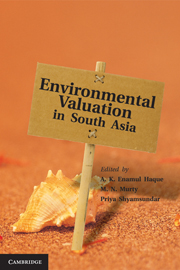Book contents
- Frontmatter
- Contents
- List of Figures
- List of Tables
- List of Appendices
- List of Contributors
- Preface
- Chapter 1 Introduction
- Chapter 2 Environmental Valuation: A Review of Methods
- Chapter 3 Valuing the Environment as a Production Input
- Chapter 4 Should Shrimp Farmers Pay Paddy Farmers?: The Challenges of Examining Salinization Externalities in South India
- Chapter 5 Evaluating Gains from De-Eutrophication of the Dutch Canal in Sri Lanka
- Chapter 6 Pesticide Productivity and Vegetable Farming in Nepal
- Chapter 7 Forests, Hydrological Services, and Agricultural Income: A Case Study from the Western Ghats of India
- Chapter 8 Can Mangroves Minimize Property Loss during Big Storms?: An Analysis of House Damages due to the Super Cyclone in Orissa
- Chapter 9 Valuation of Recreational Amenities from Environmental Resources: The Case of Two National Parks in Northern Pakistan
- Chapter 10 Valuing the Land of Tigers: What Indian Visitors Reveal
- Chapter 11 Estimating Welfare Losses from Urban Air Pollution using Panel Data from Household Health Diaries
- Chapter 12 Children in the Slums of Dhaka: Diarrhoea Prevalence and its Implications
- Chapter 13 Red Wells, Green Wells and the Costs of Arsenic Contamination in Bangladesh
- Chapter 14 Air Quality and Cement Production: Examining the Implications of Point Source Pollution in Sri Lanka
- Chapter 15 Revisiting the Need for Improved Stoves: Estimating Health, Time and Carbon Benefits
- Chapter 16 Benefits from Reduced Air Pollution in Delhi and Kolkata: A Hedonic Property Price Approach
- Chapter 17 The Value of Statistical Life
- Chapter 18 An Assessment of Demand for Improved Household Water Supply in Southwest Sri Lanka
- Index
Chapter 5 - Evaluating Gains from De-Eutrophication of the Dutch Canal in Sri Lanka
Published online by Cambridge University Press: 05 November 2012
- Frontmatter
- Contents
- List of Figures
- List of Tables
- List of Appendices
- List of Contributors
- Preface
- Chapter 1 Introduction
- Chapter 2 Environmental Valuation: A Review of Methods
- Chapter 3 Valuing the Environment as a Production Input
- Chapter 4 Should Shrimp Farmers Pay Paddy Farmers?: The Challenges of Examining Salinization Externalities in South India
- Chapter 5 Evaluating Gains from De-Eutrophication of the Dutch Canal in Sri Lanka
- Chapter 6 Pesticide Productivity and Vegetable Farming in Nepal
- Chapter 7 Forests, Hydrological Services, and Agricultural Income: A Case Study from the Western Ghats of India
- Chapter 8 Can Mangroves Minimize Property Loss during Big Storms?: An Analysis of House Damages due to the Super Cyclone in Orissa
- Chapter 9 Valuation of Recreational Amenities from Environmental Resources: The Case of Two National Parks in Northern Pakistan
- Chapter 10 Valuing the Land of Tigers: What Indian Visitors Reveal
- Chapter 11 Estimating Welfare Losses from Urban Air Pollution using Panel Data from Household Health Diaries
- Chapter 12 Children in the Slums of Dhaka: Diarrhoea Prevalence and its Implications
- Chapter 13 Red Wells, Green Wells and the Costs of Arsenic Contamination in Bangladesh
- Chapter 14 Air Quality and Cement Production: Examining the Implications of Point Source Pollution in Sri Lanka
- Chapter 15 Revisiting the Need for Improved Stoves: Estimating Health, Time and Carbon Benefits
- Chapter 16 Benefits from Reduced Air Pollution in Delhi and Kolkata: A Hedonic Property Price Approach
- Chapter 17 The Value of Statistical Life
- Chapter 18 An Assessment of Demand for Improved Household Water Supply in Southwest Sri Lanka
- Index
Summary
Introduction
Farmed shrimp is a cash crop that earns valuable foreign exchange to Sri Lanka, even though it contributes to only two per cent of world production. According to reports of the Department of Customs, shrimp exports accounted for 50 per cent of the total fisheries exports from Sri Lanka in the late nineties. The rapid growth of the industry in Sri Lanka which is concentrated in the North Western Province of Sri Lanka, has been mainly owing to initiatives of the private sector with no government support (Rohitha, 1997). Global shrimp production has grown at a phenomenal rate of 20–30 per cent per year in recent times with countries in Asia contributing to 70 per cent of world production.
The Dutch canal associated wetland system in Sri Lanka has emerged as one of the most economically important wetlands due to shrimp farming. Since the1980s, shrimp farming in the Dutch Canal has rapidly developed without any planning or coordination (Rohitha, 1997). There are more than 1300 farms covering a land area of 3750 hectares (Siriwardena, 1999) while 48 per cent of the farms (covering 40 per cent of the developed area) are illegal and unauthorized. The haphazard development of the industry has resulted in high eutrophication of the lagoon system contributing to a decline in the shrimp industry's output as well as a decrease in the lagoon's fish harvest. The shrimp industry faces frequent disease outbreaks resulting in low productivity, which could be mainly attributed to the self-imposed pollution of its source of water.
- Type
- Chapter
- Information
- Environmental Valuation in South Asia , pp. 99 - 114Publisher: Cambridge University PressPrint publication year: 2011

